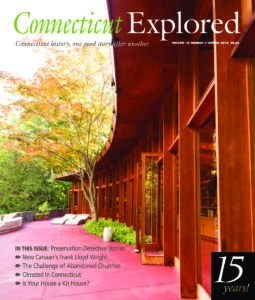(c) Connecticut Explored Inc. Spring 2018
I’m a sucker for a property with a long driveway. I love the anticipation as you turn in from the road and drive through a tunnel of forest, ideally following a few twists and turns—the suspense building—until, bam! A clearing bathed in bright sunshine reveals a cottage or camp. Imagine if hidden down that long driveway was Frank Lloyd Wright’s “largest and most elaborate private residence on the east coast”? Swoon. Bob Gregson brings his artistic eye to that Connecticut story—with his own photographs—on page 32.
Watch for other big reveals in this issue about historic preservation—in one case hidden under 10 feet of water (Site Lines, page 48) and in another, inside a barn (page 36). Uncovering these gems requires detective work. Luckily historic preservationists are detectives by nature. They want to know in detail what a place originally looked like and how it was built. They dig into archives and local land records and use scientific testing to find information. Their goal is to retain the integrity and authenticity of a place while being open to an element of transformation. Rarely can a structure remain frozen in the past—as the Connecticut Trust for Historic Preservation’s Chris Wigren eloquently describes in “Connecticut Architecture Explored,” page 20.
Compromise inevitably comes into play, as we learn in Mary Donohue’s “Saving Face” on page 46. Many times the ideal cannot be achieved, but Donohue, CT Explored’s assistant publisher and a 30+-year architectural historian, argues that sometimes saving just part of a building is still a win.
In Greenwich, the community came together to save what turned out—through more detective work—to be the oldest house in town, dating to c. 1645 (page 44). Compromise came into play in this story, too, but with the happier result that the entire structure was saved and will have a public-access component.
Thank You!
There’s no detective work required to reveal what sustains Connecticut Explored. We heartily thank our 15th Anniversary Friends of Connecticut Explored, whose support is helping us to continue publishing, produce our podcast Grating the Nutmeg, and create educational materials.
Thank you! 15th Anniversary Friends of Connecticut Explored
We are also grateful to our organizational partners, many of whom have been with us since the beginning of this collaborative effort to sustain and promote the heritage community. (We hope 2018 brings us a renewed and reinvigorated Connecticut Humanities—a vital partner to us all.)
I hope you enjoy this issue’s stories about the detective work that goes into historic preservation. We thank the State Historic Preservation Office for its support of this issue and each issue’s Site Lines story (page 48).
Read all of the stories in the Spring 2018 issue
Read all of our Historic Preservation issues on our TOPICS page

